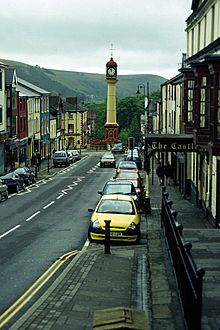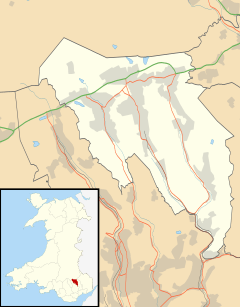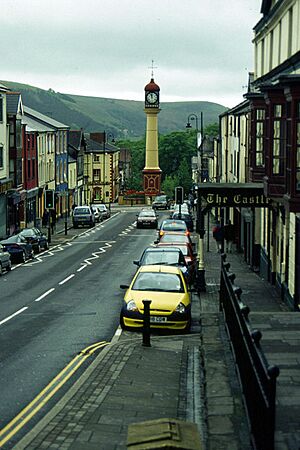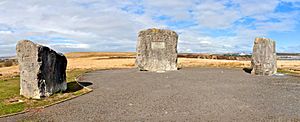Tredegar facts for kids
Quick facts for kids Tredegar |
|
|---|---|
 The Town Clock, Tredegar (April 2002) |
|
| Population | 15,103 (2011) |
| OS grid reference | SO145095 |
| Community |
|
| Principal area |
|
| Ceremonial county | |
| Country | Wales |
| Sovereign state | United Kingdom |
| Post town | TREDEGAR |
| Postcode district | NP22 |
| Dialling code | 01495 |
| Police | Gwent |
| Fire | South Wales |
| Ambulance | Welsh |
| EU Parliament | Wales |
| UK Parliament |
|
| Welsh Assembly |
|
Tredegar is a town in the southeast of Wales. It sits by the Sirhowy River in Blaenau Gwent. Long ago, it was part of Monmouthshire. Tredegar became an important place during the Industrial Revolution in Wales. In 2011, about 15,103 people lived in the town.
Contents
- What's in a Name? Tredegar's Story
- Tredegar's History
- Welsh Language in Tredegar
- Important Events: Riots
- How Tredegar Was Built
- Governance and Famous Links
- Important Buildings
- Weather in Tredegar
- Culture and Fun
- Local Schools
- Getting Around Tredegar
- Filming Location
- Famous People from Tredegar
- Twin Town
- Images for kids
- See also
What's in a Name? Tredegar's Story
The name Tredegar comes from the Tredegar Estate. This estate was a large area of land. Its main house was near Newport. The estate stretched far north into the Sirhowy Valley.
In 1800, a company called the Tredegar Iron Company was started. It was named after the Tredegar Estate. The land where the company worked belonged to the estate. So, the town that grew around the ironworks also took the name Tredegar. This is why there are two "Tredegars": the town and the original estate near Newport.
Some people used to think the name meant "ten acres" or "thirty acres." But these ideas are not correct. The name "Tredegar" actually means "farmstead of Tegyr." Tegyr was likely an old name for a person. In the local Welsh dialect, people often said "Tredecar" instead of Tredegar. Sometimes, they even shortened it to "Decar."
Tredegar's History
Before Factories and Mines
Tredegar grew because of its natural resources. The Sirhowy Valley had lots of:
- Iron ore
- Coal (to make coke for iron production)
- Water power from the fast-flowing Sirhowy River
- Wood for building and fuel
Before the 1700s, the valley was mostly woods and farms. There were a few small ironworks. Here, iron ore and coal were found close together.
The Start of Industry
The first ironworks in the Sirhowy Valley was Pont Gwaith Yr Hearn. It was built by two people from France. Later, in 1750, the Sirhowy Iron Works was set up. In 1778, new owners started using coal to power the furnaces. This led to the first small coal mining operations in the area.
The Tredegar Ironworks Company
In 1797, Samuel Homfray and his partners built a new furnace. They leased the land from the Tredegar Estate. This new company became the Tredegar Iron Company in 1800. It was named to honor the Tredegar Estate.
By 1891, the company stopped making iron. But it kept mining coal. The old ironworks were left empty. Later, in 1946, the company's coal mines became part of the National Coal Board.
Welsh Language in Tredegar
In 2011, about 5.4% of people in Tredegar could speak, read, and write Welsh. This is similar to the rest of the Blaenau Gwent area.
Important Events: Riots
Tredegar has seen three big riots in its history.
- In 1868, there were election riots. People were upset when their favorite candidate did not win.
- In 1882, a large riot happened against the Irish community. There had been some tension for a while. The riot started with stones being thrown. Soon, homes were destroyed, and furniture was burned in the streets. Soldiers from nearby towns had to come to stop the fighting.
- In 1911, there were anti-Jewish riots. Shops owned by Jewish people were attacked. The army had to be called in again. No one was killed in this riot.
How Tredegar Was Built
Samuel Homfray and his partners needed homes for their workers. So, they started building a town. In 1799, they got land to build the Tredegar Ironworks Company. Homfray even married the landowner's daughter, which helped him get better land deals.
Homfray was a strict boss. He sold special rights to businesses that wanted to open in his town. He also paid his workers with his own special money. This meant workers had to spend their wages in Tredegar.
Despite the strict rules, the chance to work made Tredegar grow very fast. In 1801, about 1,132 people lived there. By 1881, the population had grown to 34,685! This growth was helped by a horse-drawn railway built in 1805. It connected Tredegar to Newport Docks.
However, this fast growth also brought problems. The town had several cholera outbreaks in the 1800s. A special burial ground was made for cholera victims.
Governance and Famous Links
Tredegar and the Labour Party
Tredegar has strong ties to the Labour Party in Britain. It is the birthplace of Aneurin Bevan. He was the person who created the British National Health Service (NHS). In the 1920s, he helped manage the Tredegar General Hospital.
Neil Kinnock, who led the Labour Party from 1983 to 1992, was also born in Tredegar. He lived there for much of his early life. Another Labour leader, Michael Foot, was the local Member of Parliament.
Important Buildings
Bedwellty House
Bedwellty House is a beautiful old house and gardens. It was built in 1818 for Samuel Homfray. His iron and coal works were the main employers in the 1800s. The house is surrounded by a 26-acre Victorian garden. The garden has a special building called the Long Shelter. It was built for the Chartist Movement.
Town Clock
The Town Clock is a famous landmark in Tredegar. It stands tall in the town center. The clock was a gift from Mrs. R. P. Davies, whose husband managed the Tredegar Ironworks. She wanted to give the town a "lofty illuminated clock."
Weather in Tredegar
| Climate data for Tredegar (1991–2020) | |||||||||||||
|---|---|---|---|---|---|---|---|---|---|---|---|---|---|
| Month | Jan | Feb | Mar | Apr | May | Jun | Jul | Aug | Sep | Oct | Nov | Dec | Year |
| Mean daily maximum °C (°F) | 6.3 (43.3) |
6.7 (44.1) |
8.9 (48.0) |
12.2 (54.0) |
15.4 (59.7) |
17.8 (64.0) |
19.5 (67.1) |
19.8 (67.6) |
16.7 (62.1) |
13.0 (55.4) |
9.2 (48.6) |
6.8 (44.2) |
12.7 (54.9) |
| Mean daily minimum °C (°F) | 1.2 (34.2) |
1.0 (33.8) |
2.2 (36.0) |
3.8 (38.8) |
6.5 (43.7) |
9.6 (49.3) |
11.4 (52.5) |
11.5 (52.7) |
9.2 (48.6) |
6.9 (44.4) |
3.9 (39.0) |
1.6 (34.9) |
5.8 (42.4) |
| Average rainfall mm (inches) | 206.2 (8.12) |
157.2 (6.19) |
125.8 (4.95) |
102.8 (4.05) |
101.2 (3.98) |
83.8 (3.30) |
105.8 (4.17) |
115.2 (4.54) |
124.9 (4.92) |
189.3 (7.45) |
184.9 (7.28) |
218.8 (8.61) |
1,715.8 (67.55) |
| Mean monthly sunshine hours | 40.1 | 69.3 | 107.0 | 159.2 | 183.8 | 175.6 | 191.3 | 171.5 | 137.1 | 83.7 | 57.6 | 45.9 | 1,422 |
| Source: Met Office | |||||||||||||
Culture and Fun
- The Tredegar Town Band started in 1849. They take part in national music contests.
- The Tredegar Orpheus Male voice choir began in 1909. They are named after Orpheus, the Greek god of music.
- Tredegar has two rugby union teams: Tredegar RFC and Tredegar Ironsides RFC.
- Bryn Bach Park is a lovely country park in Tredegar.
- The Blaenau Gwent Film Academy is in Tredegar. It helps young people aged 7-18 learn to make films. They have made award-winning films like "Life of a Plastic Cup."
Local Schools
Tredegar has many schools, both old and new:
- The Town School (opened 1837)
- Georgetown schools (opened 1877)
- Sirhowy School
- Tredegar Grammar School
- Tredegar Secondary Modern
- Tredegar Comprehensive school
- Deighton primary school
- Glanhowy primary school
- Georgetown primary school (rebuilt 2004)
- St. Joseph's R.C school
- Brynbach primary school
Getting Around Tredegar
As Tredegar grew with industry, it needed good transport.
- In 1805, a horse-drawn railway connected Tredegar to Newport Docks. It was 24 miles long.
- In 1829, a steam train was bought. It made its first trip on December 17, 1829.
- The railway closed in 1963. Now, the closest train stations are in Ebbw Vale, Rhymney, and Abergavenny.
- There are plans for a new train station in Tredegar as part of the South Wales Metro.
For many years, two bus companies served Tredegar: Red & White Services and Hill's of Tredegar. Red & White opened a new Bus Station in Tredegar in 1959.
Filming Location
Tredegar and the nearby Trefil region have been used for many TV shows and movies:
- The District Nurse starring Nerys Hughes.
- The Citadel (1982 TV series) was filmed in Tredegar. The story was based on a doctor's experiences in the town. The Tredegar Medical Aid Society from the town helped inspire the British National Health Service.
- In 2005, Trefil was used as the alien Vogon homeworld in The Hitchhiker's Guide to the Galaxy movie.
- In 2011, parts of a Clash of the Titans sequel were filmed in Trefil.
- Trefil has also appeared in the Doctor Who universe.
- In 2008, a car crash scene for a short film called Cow was filmed on the Tredegar bypass. This film warned about the dangers of texting while driving.
- The independent movie A Bit of Tom Jones? was filmed in and around Tredegar in 2010.
- The Doctor Who episode "The Hungry Earth" was filmed in Bedwellty Pits in 2010.
- In 2018, the Blaenau Gwent Film Academy in Tredegar adapted Stephen King's short story "Stationary Bike." It was filmed in Tredegar and Trefil.
Famous People from Tredegar
Many notable people have come from Tredegar:
- Aneurin Bevan: A famous Labour politician who created the National Health Service.
- Neil Kinnock: A former leader of the Labour Party.
- Mark Colbourne: Won gold and silver medals at the 2012 Summer Paralympics.
- Ray Reardon: A six-time World Snooker Champion.
- Nicky Wire: Lyricist and bassist for the band Manic Street Preachers.
- Patrick Jones: A poet, playwright, and filmmaker.
- James Davis: A U.S. Senator and founder of Moose International.
Twin Town
Since 1979, Tredegar has been twinned with Orvault in France.
Images for kids
See also
 In Spanish: Tredegar para niños
In Spanish: Tredegar para niños





